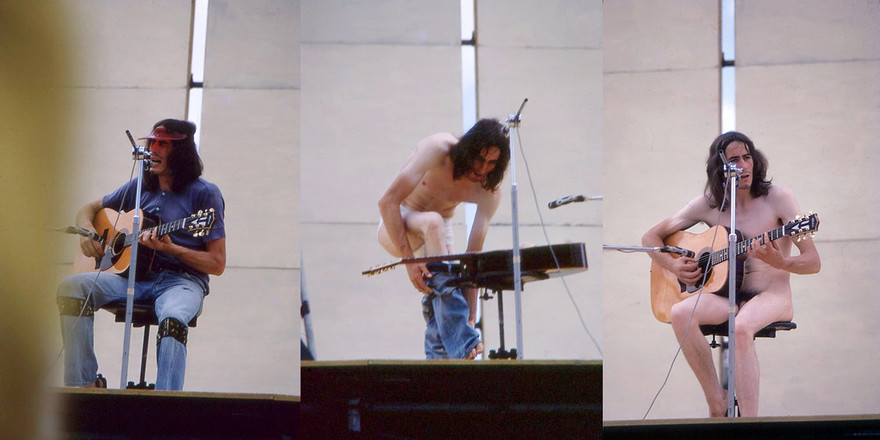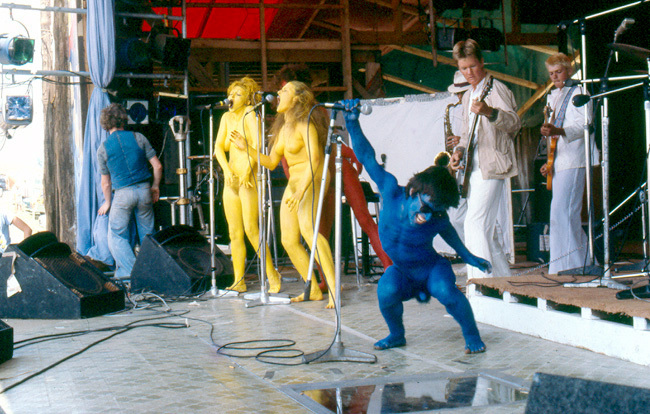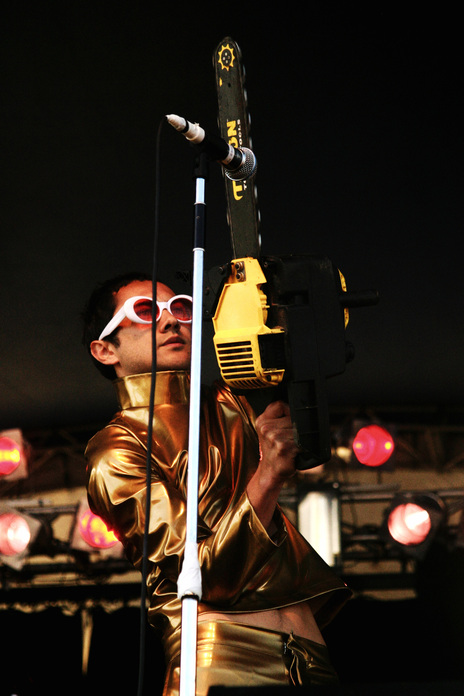A festival slot is always a risky proposition for a musical act. There’s only a short amount of time to set up, no chance for a soundcheck, and an audience who may or may not be in the mood for that type of music. Then there might be a scheduling clash with one of the main acts, so that the audience disappears before the musicians even get started.
However, there’s also the opportunity for an act to put themselves in front of a bunch of new listeners and blow their socks off. Sometimes it might be a matter of luck. Simon Grigg once told me that The Screaming Meemees were incredibly nervous before their slot going on just before the headliners at Sweetwaters in 1983, so when Grigg heard that New Zealand had just beaten Australia at cricket he told the band to inform the audience. This raised an immediate cheer from the crowd and set them off on the best festival appearance of their career.
This list looks at similar moments when a local act took the opportunity to rise above the rest and etch themselves into the minds of audience members for all time. It is worth noting that many of the early New Zealand music festivals had line-ups consisting largely of pākeha dudes with guitars. This list attempts to surpass this ongoing bias, but it’s hard to avoid. What’s more, people’s festival experiences are very personal so there’s no hope of being authoritative – so it would be great to hear further suggestions via our Facebook page.
Corben Simpson at the Great Ngāruawāhia Music Festival
The Great Ngāruawāhia Music Festival scandalised the local press because of the nudity amongst attendees. Such open-minded behaviour was appealing to Corben Simpson. Despite receiving fame as a popular solo act (having won the 1971 APRA Silver Scroll Award for ‘Have You Heard A Man Cry’), he also had one foot in the counterculture through being part of BLERTA and performed with them at Ngāruawāhia. BLERTA made their name by touring the country in a brightly painted bus and putting on performances that alternated between family entertainment and jazz-influenced music.
Simpson began feeling hot halfway through his solo set, so he gradually removed all his clothes. Members of the crowd began de-robing and throwing their own clothes in the air, but his act of rebellion did have some unfortunate results – his family at home were horrified when they saw him being scorned on the evening news and the police subsequently fined him $500.

Corben Simpson onstage, Great Ngāruawāhia Music Festival, 1973. - Dave Stone
Split Enz at Nambassa
The Nambassa Festival started in 1978 and the counterculture vibe was still in evidence. This time it was The Plague who drew attention with not only nudity, but full body paint.

The Plague on the main stage, Nambassa Festival, Waihi, 1979. - Photo by Gerald Couper
However, the performance at the festival with the biggest impact was undoubtedly by Split Enz, though they had to overcome some hurdles first. Their caravan backstage was smeared blue, yellow, and red after a certain other band had used it to cover their naked skin in body paint! More seriously, the Waihi hall where Split Enz had been practising before the festival was burnt to the ground, along with their equipment.
However, Split Enz had survived years of living hand-to-mouth in the UK, so didn’t let their incinerated gear ruin the night. They borrowed the gear they needed and took to the stage with confidence undimmed. The crowd were up for it, giving them a “reception bordering on hysteria”, as reported by the Auckland Star.
Their former bass player Mike Chunn was in the audience and realised that he was seeing a world-class performance:
“I was blown out of my high perch by an inspired, awesome display of edgy, driving pop music. They took the crowd up with ‘I See Red’ and took them low with ‘Stuff and Nonsense’; crazed them with ‘Frenzy’ and made them laugh with ‘True Colours’ … Just magnificent.”

Split Enz at Nambassa, 1979. - Susanna Burton
Mi-Sex at Sweetwaters
In the world of the music snob, there are few worse crimes than a musician wanting fame too much. Steve Gilpin played his hand early on by beating Shona Laing to win the New Faces TV talent competition, looking like a 70s cabaret singer with his long hair and moustache. It didn’t help that his subsequent band made such a sharp turn from having flared trousers and hippie haircuts to being short-haired and new wave. Their first single flopped locally so they split for Australia and toured themselves to the bone, creating a profile for themselves pub-by-pub.
By 1980, Mi-Sex already had a platinum album in Australia (Graffiti Crimes) and a single (‘Computer Games’) that reached No.1 there and entered the Top 20 in Germany and Austria. They rivalled Split Enz for the position of New Zealand’s hottest overseas musical export and at Sweetwaters in 1980 they finally had a high profile opportunity to show local fans what they’d been missing. Rip It Up reviewer Duncan Campbell was blown away:
“The festival belonged to Mi-Sex … They flattened the crowd with a set that was nothing short of devastating. Steve Gilpin seemed tireless in his acrobatics and Kevin Stanton was masterful.”
Straitjacket Fits at Mountain Rock
At the beginning of 1994, Straitjacket Fits had been ground down by endless tours of the US and Europe/UK, without any big break forthcoming. The decision was made to bring the band to an end, though not without a few last shows. They were perhaps an unlikely addition to the line-up at Mountain Rock, since it was “hard rock” rather than the indie variety that brought the punters out to this festival.
Like Split Enz and Mi-Sex before them, the effect of relentless touring had turned SJF into a taut machine and lead singer Shayne Carter was now in full control of his simmering charisma. Colin Hogg reviewed their performance at Mountain Rock: “The rain was still about when Straitjacket Fits hit the stage to deliver a fearsome performance that must have put a quiver into all those black jeans out there.”
A month later, the band would play the last show of their initial run as a band by closing Big Day Out. Organiser Doug Hood recalls that his confidence in giving them the spot was more than rewarded: “Straitjacket Fits were stunning, just how convincing they were.”
The footage from the Mountain Rock set captures a band at its peak – rain streaming down their faces, ferocious sounds blasting out of their amps, while the crowd leaps up and down in waves.
Unitone HiFi at The Gathering
The Gathering was an ambitious endeavour – a multi-stage dance event on the top of the Tākaka ranges, surrounded by dense forest and hundreds of kilometres from civilisation (at least in terms of what you might need to run a music festival).
One of the original founders was music writer Grant Smithies, who says that one particular performance in the first year made him realise that the event was truly something special:
“At the very first 96/97 Gathering, Stinky Jim, Joost Langeveld, and Angus McNaughton played as Unitone HiFi in a marquee. It seemed someone had left a brick on the smoke machine button and mighty basslines and synth lines kept erupting out of the fog, drifting out across limestone crags and rolling paddocks and thick bush. Bright lights pulsed and twinkled, illuminating the faces of thousands of pilgrims who’d travelled from all over the country to see in the New Year in style. Their mix of Jamaican dancehall, New York hip hop and some other indefinable Pacific flavour struck me as bold, original, an exciting new direction for local music. It was certainly an unusual sound to hear booming out down the end of a narrow one-lane road on the top of Tākaka Hill. It felt like dance culture in Aotearoa infiltrating new places.”

Unitone HiFi - Joost Langeveld & Stinky Jim
Fat Freddy’s Drop at Splore
The new millennium would see an even longer running dance music festival starting up. Splore is held in an equally scenic spot, though not quite as out-of-the-way as The Gathering. John Minty has been one of the organisers since the 2006 event onward and he says that one of his highlights at the festival in recent years was BLKCITY – the all-star group made up of rappers Jess B, Raiza Biza, Mo Muse, Blaze The Emperor and Abdul Kay (all Aotearoa raised, but of African descent). It’s worth seeking out the short doco about the performance by RNZ.
However, taking a more long-term view, the most important and eye-opening set at Splore was surely the one by Fat Freddy’s Drop in 2002. In those days, Splore was held in Waharau Regional Park (not far from the current site within Tapapakanga Regional Park). At that point in time, Fat Freddy’s Drop’s only release was the Live at the Matterhorn EP (2001) and they’d played relatively few shows outside of Wellington.
This meant that many of the audience at Splore were not expecting the full dubbed-out Freddy’s assault of throbbing beats, catchy horn lines, soulful vocals, and skanking guitar. Minty says it was a truly special performance and footage from it was used for their debut music video for ‘Hope’.
Fat Freddy’s Drop returned to Splore in later years, including a set during the year when it rained heavily and the “mud people” took over much of the crowd. Another very memorable festival moment!
Hollie Smith joins Trinity Roots at Soundsplash
The TrinityRoots set at Soundsplash was always going to be a special one, since they’d announced that it would be their last show (though they did manage to squeeze in a short set at a charity gig, before the original trio parted ways). Their platinum album Home, Land and Sea (2004) featured standout backing vocals by a then-little-known young singer named Hollie Smith and she agreed to join them for the show.
Not only did the audience get to see the TrinityRoots performing songs off their award-winning album at one of the most scenic festival spots in the country – a natural amphitheatre not far from the wild Raglan coast – but many audience members also discovered the charms of Hollie Smith for the first time. Her booming gospel voice was a perfect match for Warren Maxwell’s gravelly tone, even if sometimes the sheer power of her delivery threatened to take over. It would be two years before she released her breakthrough debut album, but anyone present there that day would’ve already had no doubt that they were witnessing a star in the making.
Mint Chicks at Big Day Out
It would be easy enough to fill this article entirely from performances from the Big Day Out, given that it ran in New Zealand all the way from 1994 to 2012. There are plenty of moments that could be highlighted here, whether it’s Dion from The D4 walking across the audience; the recurring brilliance of Shihad which saw the early evening slot renamed the “Shihad slot”; Scribe bringing hip hop to the main stage for the first time; Killer Ray, a 60s jazz musician turned masked cult act at the Lilypad; or Shapeshifter becoming the first local act to close the Boiler Room. However, I’ll restrain myself to only one of the many performances at the event:
In 2004, The Mint Chicks were disgusted to find that an advertiser’s sign protruded up in front of the stage, obscuring the crowd’s view of the band. Lead singer Kody Nielson took matters into his own hands by walking out wielding a chainsaw and he made quick work of cutting down the offending sign, before the band ripped into a killer set.

Kody Nielson at the 2005 Big Day Out - Photos by Ian Jorgensen (Blink)
Bachelorette Plays with Robot Band The Trons at Camp A Low Hum
Camp A Low Hum organiser Ian Jorgensen had been running tours throughout Aotearoa for many years, so when he started his own festival, he had the confidence to experiment. He chose unusual locations, including an old scout facility and an abandoned school. It led to very unique performance stages – one was in an emptied out swimming pool, another was right next to a lake, while acts also played in barns, squash courts, and out the back of a moving van.
Looking back, he says that So So Modern were one of his go-to acts at the time and he struggled to keep to his rule of not having artists play two years in a row when it came to them. He did break this rule once when the band offered to write an entire set of new material specifically for the festival and he found the results were overwhelming: “I was standing in the wings watching the audience and people up the front were overcome with emotion.”

Bachelorette (Annabel Alpers) and the Trons, Camp A Low Hum, 2011.

Bachelorette and the Trons, Camp A Low Hum, 2011. - Gareth Shute
Another stand-out performance was the set delivered by Bachelorette in 2011, which saw her play alongside a band of programmed robots. These musical oddities were created by sound engineer Greg Locke (Hollow Grinders), who constructed each mechanism specifically to interact with its given instrument and then created a program to run them all together using the electronics from an old photocopier card-vending machine. Their backyard construction gave The Trons a raw, indie sound which contrasted nicely with Bachelorette’s wonderfully controlled (some might say robotic) musical approach. The result was unforgettably surreal.
Chris Knox and the Nothing at Laneway
In 2009, Chris Knox was struck with a debilitating stroke that robbed him of much of his speech. It also meant headaches and an increased risk of his epilepsy causing a seizure. For any other musician, this would’ve meant the end of their music career, but Knox has always been one to push up against any restriction that is placed in front of him.
So it was that Knox took his group to the stage at Laneway the very next year. He might’ve lost most of his words, but none of his passion or ability to deliver a melody. His voice remained unmistakable, and he stalked the stage with the same quiet ferocity as he had for decades. The crowd roared in recognition, not only of the performance but the man himself.

Chris Knox and The Nothing at Laneway, Auckland, 1 February 2010, with Shayne Carter on guitar, Roy Martyn on bass and Stefan Neville on drums - Photo by Jackson Perry
--